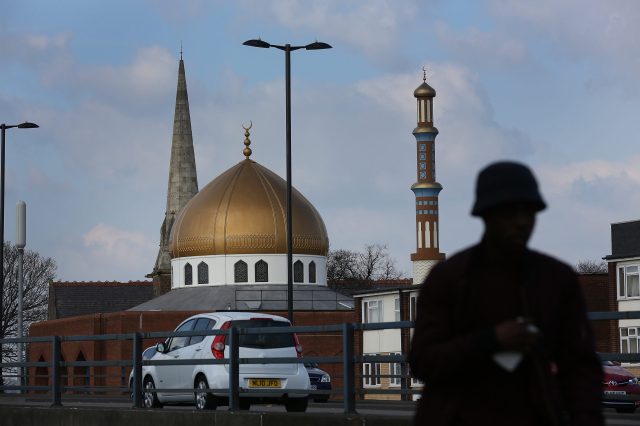(Photo of mosque alongside church in Birmingham, England, by Christopher Furlong/Getty Images)

Who could forget the horrors of September 2015, when thousands of desperate people put their lives in danger in an effort to get to Europe? The picture of Aylan Kurdi, one of the little boys who didn’t make it, touched millions of hearts.
I wrote last year about the traumas many of them had already experienced before they arrived. Now, new research from US-based Pew Research Center looks ahead to the implications of this sudden mass migration. What will the religious landscape of European countries look like in thirty years’ time, when the newly arrived people have settled and their children and grandchildren are part of our communities?
First, the caveats:
Pew are very clear that their research offers projections, and not predictions. Demographic forecasting is an art as well as a science, but it’s important to note that Pew had already published religious demography projections and then felt the need to change them after the mass migration of 2015. The refugee crisis changed the picture significantly.
The data they published this week drew from population statistics from September 2016, and extrapolated using assumptions about age and family size. Their analysis also makes some important points about the asylum process, and Pew have assumed that nearly a million Muslims who arrived in Europe in the last couple of years will not have their application for asylum approved, on the basis of past approval rates.
There will be more Muslims
Pew found that Muslims currently living in Europe are generally slightly younger than the average host populations – by 13 years, on average – and that they usually have one more child per family. We know that religious identity is transmitted primarily from parent to child which, along with other factors, means that it is reasonable to assume that there will be higher proportions of Muslims in most European countries by 2050. This is particularly likely in countries with younger Muslim populations and the largest families, including Italy, France and Belgium.
Pew have calculated three scenarios, based on high, medium and zero migration from this point. Even if there were no more migration into Europe at all, the Muslim population would rise from 4.9% (as it is now) to 7.4% by 2050, according to Pew. Under the ‘medium’ scenario, which assumes all refugee arrivals would stop but that immigration based on other reasons would continue, Pew suggest that Muslims could form 11.2% of the European population by 2050. And in the ‘high’ scenario, which allows for increased refugee arrivals, we might see 14% of Europe’s population identifying as Muslim by 2050.
Will there be more Christians?
It’s important to note that almost half (47%) of the people who arrived recently in Europe are not Muslims, and that Christians are the next largest religious group. Usually, religious people who arrive in a Western country from elsewhere are more highly observant than the communities in which they settle. Ten years ago, Catholic churches in Britain were noticing an increase in Polish worshippers. It’s possible that this may be reflected in our religious landscape over the next generation.
Settling in
In Western countries, while first and second generation diaspora are often highly religious, it’s not unusual to find that by the third and fourth generation, people have settled in to their host community so much that they become less highly observant. Britain’s population currently identifies more as No Religion (53%) than all other religious affiliations combined, and the implications of assimilation are commonly discussed by faith leaders across many traditions – Nigerian church leaders, Pakistani imams, etc. If Pew’s ‘zero migration’ scenario holds true, then it’s possible that we will eventually settle back to a broadly secular culture, with some religious practice among significant minorities.
Rubbing along together
In the meantime, there are clear challenges for European countries. In our work with employers who commission us for research and consultancy on faith in the workplace, we regularly hear stories of Muslims struggling to be accepted in the workforce. Muslim women tell of taking their headscarf off before interview, in case the recruiter is put off, or of being asked questions which assume they aren’t free to make their own decisions: “are you SURE you’re able to travel?”And Muslim men who work as drivers – delivering take-aways, or driving a bus – are often subject to verbal abuse, and worse. One global retailer recently called me for advice about a situation in Belgium, where the narrative about radicalisation is strong, and some people travel onwards to Syria. They had found that if they put someone on the checkout who looked as though they were Muslim, customers would yell at them or refuse to be served by them.
There are labour market challenges to face, among others, whichever of Pew’s scenarios come to pass, or even if none of them do. Muslims are here, and they are here to stay.










Join the discussion
Join like minded readers that support our journalism by becoming a paid subscriber
To join the discussion in the comments, become a paid subscriber.
Join like minded readers that support our journalism, read unlimited articles and enjoy other subscriber-only benefits.
Subscribe